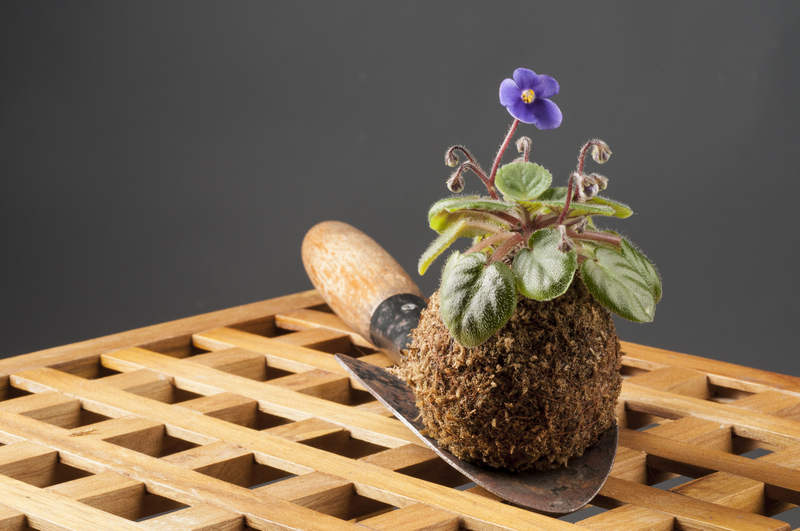Vertical Gardening: A Green Revolution in Urban Living
Posted on 14/08/2025
Vertical Gardening: A Green Revolution in Urban Living
Introduction to Vertical Gardening
Urban living often comes with its set of challenges - limited space, pollution, and a disconnect from nature. However, innovative solutions are emerging, bringing nature back into our cities. One such solution is vertical gardening, an approach to gardening that takes advantage of vertical spaces to cultivate plants. Whether you live in a high-rise apartment, a small townhouse, or have a modest yard, vertical gardens make green spaces accessible, transforming bare walls, balconies, and fences into lush, living works of art. This green revolution is reshaping the landscape of urban environments and empowering residents to live more sustainably.

What is Vertical Gardening?
Vertical gardening is the practice of growing plants upward on structures like trellises, walls, or stacked containers instead of horizontally on the ground. This method is also known as vertical landscaping, living walls, or green walls. These gardens can be as simple as hanging pots or as elaborate as professionally installed hydroponic systems covering entire building facades. Vertical gardening solutions provide opportunities for urban agriculture and enhance the aesthetic appeal of cityscapes.
Why is Vertical Gardening Important?
- Maximizes limited space in densely populated cities.
- Improves air quality by filtering pollutants.
- Reduces the urban heat island effect.
- Increases local food production in urban areas.
- Creates green sanctuaries for mental and physical well-being.
Benefits of Vertical Gardening in Urban Environments
Vertical gardening techniques offer a wide range of advantages, making them especially valuable in cities. Let's explore the remarkable benefits that this form of gardening brings to urban dwellers and the environment.
1. Space Efficiency
The most significant advantage of vertical gardening is that it helps you maximize your available space. In crowded cities where ground space is scarce, vertical systems allow for bountiful crops or lush ornamental foliage along otherwise unused walls and fences. Container gardens and modular vertical planters can fit even the tiniest apartment balcony.
2. Enhanced Air Quality
Modern cities face air quality issues due to traffic and industrialization. Green walls naturally filter the air by absorbing carbon dioxide and releasing oxygen. Certain plants in vertical gardens can even help remove toxins such as VOCs (volatile organic compounds) from the atmosphere, promoting a healthier environment.
3. Reduced Urban Heat Island Effect
Concrete and asphalt absorb and retain heat, making cities warmer than their rural counterparts--a phenomenon called the urban heat island effect. Vertical gardens provide natural insulation for buildings, reflecting sunlight and reducing indoor cooling costs during hot months.
4. Improved Mental Health
Being around greenery has a proven positive impact on mental well-being. Having a living wall or a small urban vertical garden offers city residents the opportunity to connect with nature, reduce stress, and boost their mood and productivity.
5. Local Food Production
Edible vertical gardens make it possible to grow herbs, vegetables, and even some fruits right at home. This supports food security by supplementing store-bought produce with fresh, homegrown options, reducing your carbon footprint and grocery bill.
6. Biodiversity and Habitat Creation
Vertical gardens attract beneficial insects and birds, restoring biodiversity that might otherwise be lost in concrete-heavy cities. Pollinators and other wildlife can thrive on urban green walls, helping maintain healthy ecosystems.
Types of Vertical Garden Systems
Vertical gardening comes in a variety of forms, each suited to different spaces, climates, and levels of expertise. Here are some common vertical gardening methods:
1. Trellis and Lattice Gardens
A trellis garden uses a simple frame made from wood or metal, providing support for climbing plants like beans, peas, cucumbers, or flowering vines. Lattices can help transform empty wall spaces into vibrant green panels.
2. Green/ Living Walls
Living walls or green walls are vertical surfaces completely covered by vegetation, often using hydroponic systems. These installations can be constructed indoors or outdoors and frequently incorporate automated irrigation and fertilization.
3. Pocket Planters and Wall Planters
Fabric or plastic pocket planters are mounted onto walls and filled with soil and plants. These modular vertical gardens are lightweight and customizable, making them ideal for balconies, patios, or indoor areas with limited space.
4. Hanging Gardens and Shelving
For a more DIY approach, consider hanging pots, baskets, or shelves to display an assortment of plants. This approach is flexible and allows for creative arrangements using repurposed materials.
5. Tower Gardens
Tower gardens use stacked containers or columns equipped with irrigation systems. These are perfect for growing herbs, vegetables, and lettuces in small areas. Some towers use soil, while others are hydroponic or aeroponic.
Best Plants for Vertical Gardening
Choosing the right vertical garden plants is crucial for a thriving urban green wall or pocket garden. Consider light, temperature, maintenance, and water needs before selecting your greenery.
Popular Edible Plants
- Herbs: Basil, mint, thyme, parsley, oregano, and chives
- Leafy greens: Spinach, lettuce, arugula, Swiss chard
- Small fruiting plants: Strawberries, cherry tomatoes, peppers
- Climbers: Beans, peas, cucumbers
Ornamental Favorites
- Ferns and mosses for shaded or indoor spaces
- Pothos, philodendron, and ivy for cascading greenery
- Succulents and cacti for sunny balconies
- Flowering vines like jasmine or morning glory
How to Start Your Own Vertical Garden
Are you ready to join the vertical gardening movement? Starting your own vertical garden in an urban setting is easier than you might think. Follow these steps to bring this green revolution to your home or community.
Step 1: Assess Light and Space
Evaluate where you have available vertical surfaces: blank walls, fences, balconies, or even railings. Determine the light conditions of your chosen space--full sun, partial sun, or shade--so you can choose suitable plants.
Step 2: Choose the Right Vertical System
Select a system based on your space, budget, and DIY skills. Trellises, hanging planters, modular wall pockets, or commercial living wall kits are all great options for beginners and advanced gardeners alike.
Step 3: Select Plants
Pick plant varieties that suit your climate and the light in your chosen location. For edible gardens, prioritize robust, quick-growing crops. For ornamental gardens, consider foliage variety and texture.
Step 4: Prepare Structures and Soil
Install your chosen framework securely. Use quality potting mix or hydroponic media (if you're growing without soil) and ensure proper drainage to prevent root rot. If using soil, select mixes enriched with compost for strong plant health.
Step 5: Plant and Maintain
Plant your seeds or seedlings according to spacing recommendations. Establish a watering schedule, using drip irrigation or self-watering systems if needed. Regularly fertilize and prune to keep your vertical garden thriving.
Innovative Vertical Gardening Ideas for City Dwellers
If you're looking to get creative, here are some innovative approaches to vertical gardening in small spaces:
- Repurpose old pallets, shoe organizers, or gutters as planters.
- Create an herb wall using recycled mason jars and a wooden frame.
- Install a hydroponic vertical garden for soil-free, high-yield growing indoors.
- Hang rows of small planters along balcony or stair railings.
- Use metal mesh or wire grids as trellises for climbing vegetables.
Vertical Gardening: Sustainability and the Future of Urban Agriculture
Vertical urban farming isn't just a home improvement trend--it is paving the way for a sustainable future. As cities continue to grow, vertical gardens offer solutions to urban challenges:
- Food Security: By turning vertical spaces into productive farms, cities can reduce reliance on imported produce and shorten food supply chains.
- Climate Resilience: Green walls shield buildings from temperature extremes, storm damage, and increase city-wide resilience to climate events.
- Environmental Restoration: More greenery means improved urban biodiversity, healthier air, and reduced noise pollution.
- Social Well-being: Community-led vertical gardening projects strengthen neighborhood bonds and provide educational opportunities for sustainable living.
Vertical Farming Versus Home Vertical Gardening
It's important to note that vertical farming, usually commercial and technology-intensive, is different from the DIY vertical gardens you'd build at home. However, both approaches complement each other, promoting local, sustainable food production on different scales. Whether you're cultivating a small balcony garden or supporting a high-tech vertical farm, you're contributing to the worldwide green urban revolution.

Challenges and Considerations
While the advantages are significant, vertical gardening in cities does come with its own set of challenges:
- Weight and Structural Integrity: Make sure that your wall, fence, or balcony can support the weight of planters, soil, and water.
- Water Management: Overwatering can cause leaks and water damage--always design for proper drainage.
- Maintenance: Vertical garden systems may need regular care to prune, water, and replace plants as needed.
- Cost: Some vertical gardening kits or hydroponic systems can be expensive upfront, though costs are offset by produce and energy savings over time.
Conclusion: Embrace Vertical Gardening and Join the Green Revolution
In a world where urbanization is accelerating, vertical gardening shines as a practical, beautiful, and sustainable solution for city living. These gardens take innovation in stride, turning grey cityscapes into vibrant, thriving ecosystems. Whether you want to grow your own food, add privacy, purify the air, or simply enjoy the serenity of greenery, vertical gardening empowers you to be part of the green revolution transforming urban environments.
Ready to take your first step? Start small--add a few pocket planters to your balcony or embark on a full-scale living wall project. Every plant counts towards building healthier, greener cities for generations to come. Vertical gardens are not just a trend; they are the future of urban sustainability. Now is the perfect time to discover how vertical gardening can revolutionize your home, your city, and your quality of life.

